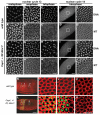dFMRP and Caprin, translational regulators of synaptic plasticity, control the cell cycle at the Drosophila mid-blastula transition
- PMID: 21068064
- PMCID: PMC2990211
- DOI: 10.1242/dev.055046
dFMRP and Caprin, translational regulators of synaptic plasticity, control the cell cycle at the Drosophila mid-blastula transition
Abstract
The molecular mechanisms driving the conserved metazoan developmental shift referred to as the mid-blastula transition (MBT) remain mysterious. Typically, cleavage divisions give way to longer asynchronous cell cycles with the acquisition of a gap phase. In Drosophila, rapid synchronous nuclear divisions must pause at the MBT to allow the formation of a cellular blastoderm through a special form of cytokinesis termed cellularization. Drosophila Fragile X mental retardation protein (dFMRP; FMR1), a transcript-specific translational regulator, is required for cellularization. The role of FMRP has been most extensively studied in the nervous system because the loss of FMRP activity in neurons causes the misexpression of specific mRNAs required for synaptic plasticity, resulting in mental retardation and autism in humans. Here, we show that in the early embryo dFMRP associates specifically with Caprin, another transcript-specific translational regulator implicated in synaptic plasticity, and with eIF4G, a key regulator of translational initiation. dFMRP and Caprin collaborate to control the cell cycle at the MBT by directly mediating the normal repression of maternal Cyclin B mRNA and the activation of zygotic frühstart mRNA. These findings identify two new targets of dFMRP regulation and implicate conserved translational regulatory mechanisms in processes as diverse as learning, memory and early embryonic development.
Figures






Similar articles
-
Proteomic analysis reveals CCT is a target of Fragile X mental retardation protein regulation in Drosophila.Dev Biol. 2010 Apr 15;340(2):408-18. doi: 10.1016/j.ydbio.2010.01.028. Epub 2010 Feb 1. Dev Biol. 2010. PMID: 20122915 Free PMC article.
-
Temporal requirements of the fragile X mental retardation protein in the regulation of synaptic structure.Development. 2008 Aug;135(15):2637-48. doi: 10.1242/dev.022244. Epub 2008 Jun 25. Development. 2008. PMID: 18579676 Free PMC article.
-
Fragile X mental retardation protein controls trailer hitch expression and cleavage furrow formation in Drosophila embryos.Proc Natl Acad Sci U S A. 2006 Nov 28;103(48):18160-5. doi: 10.1073/pnas.0606508103. Epub 2006 Nov 16. Proc Natl Acad Sci U S A. 2006. PMID: 17110444 Free PMC article.
-
Timing the Drosophila Mid-Blastula Transition: A Cell Cycle-Centered View.Trends Genet. 2016 Aug;32(8):496-507. doi: 10.1016/j.tig.2016.05.006. Epub 2016 Jun 20. Trends Genet. 2016. PMID: 27339317 Free PMC article. Review.
-
From egg to gastrula: how the cell cycle is remodeled during the Drosophila mid-blastula transition.Annu Rev Genet. 2014;48:269-94. doi: 10.1146/annurev-genet-111212-133531. Epub 2014 Sep 5. Annu Rev Genet. 2014. PMID: 25195504 Free PMC article. Review.
Cited by
-
centrocortin RNA localization to centrosomes is regulated by FMRP and facilitates error-free mitosis.J Cell Biol. 2020 Dec 7;219(12):e202004101. doi: 10.1083/jcb.202004101. J Cell Biol. 2020. PMID: 33196763 Free PMC article.
-
The RNA-binding proteins FMR1, rasputin and caprin act together with the UBA protein lingerer to restrict tissue growth in Drosophila melanogaster.PLoS Genet. 2013;9(7):e1003598. doi: 10.1371/journal.pgen.1003598. Epub 2013 Jul 11. PLoS Genet. 2013. PMID: 23874212 Free PMC article.
-
Crystal structure of a dimerization domain of human Caprin-1: insights into the assembly of an evolutionarily conserved ribonucleoprotein complex consisting of Caprin-1, FMRP and G3BP1.Acta Crystallogr D Struct Biol. 2016 Jun;72(Pt 6):718-27. doi: 10.1107/S2059798316004903. Epub 2016 May 25. Acta Crystallogr D Struct Biol. 2016. PMID: 27303792 Free PMC article.
-
Regulation of molecular pathways in the Fragile X Syndrome: insights into Autism Spectrum Disorders.J Neurodev Disord. 2011 Sep;3(3):257-69. doi: 10.1007/s11689-011-9087-2. Epub 2011 Aug 13. J Neurodev Disord. 2011. PMID: 21842222 Free PMC article.
-
Embryonic onset of late replication requires Cdc25 down-regulation.Genes Dev. 2012 Apr 1;26(7):714-25. doi: 10.1101/gad.186429.111. Epub 2012 Mar 19. Genes Dev. 2012. PMID: 22431511 Free PMC article.
References
-
- Aerbajinai W., Lee Y. T., Wojda U., Barr V. A., Miller J. L. (2004). Cloning and characterization of a gene expressed during terminal differentiation that encodes a novel inhibitor of growth. J. Biol. Chem. 279, 1916-1921 - PubMed
-
- Anderson P., Kedersha N. (2009). RNA granules: post-transcriptional and epigenetic modulators of gene expression. Nat. Rev. Mol. Cell Biol. 10, 430-436 - PubMed
-
- Arbeitman M. N., Furlong E. E., Imam F., Johnson E., Null B. H., Baker B. S., Krasnow M. A., Scott M. P., Davis R. W., White K. P. (2002). Gene expression during the life cycle of Drosophila melanogaster. Science 297, 2270-2275 - PubMed
Publication types
MeSH terms
Substances
Grants and funding
LinkOut - more resources
Full Text Sources
Molecular Biology Databases
Miscellaneous

